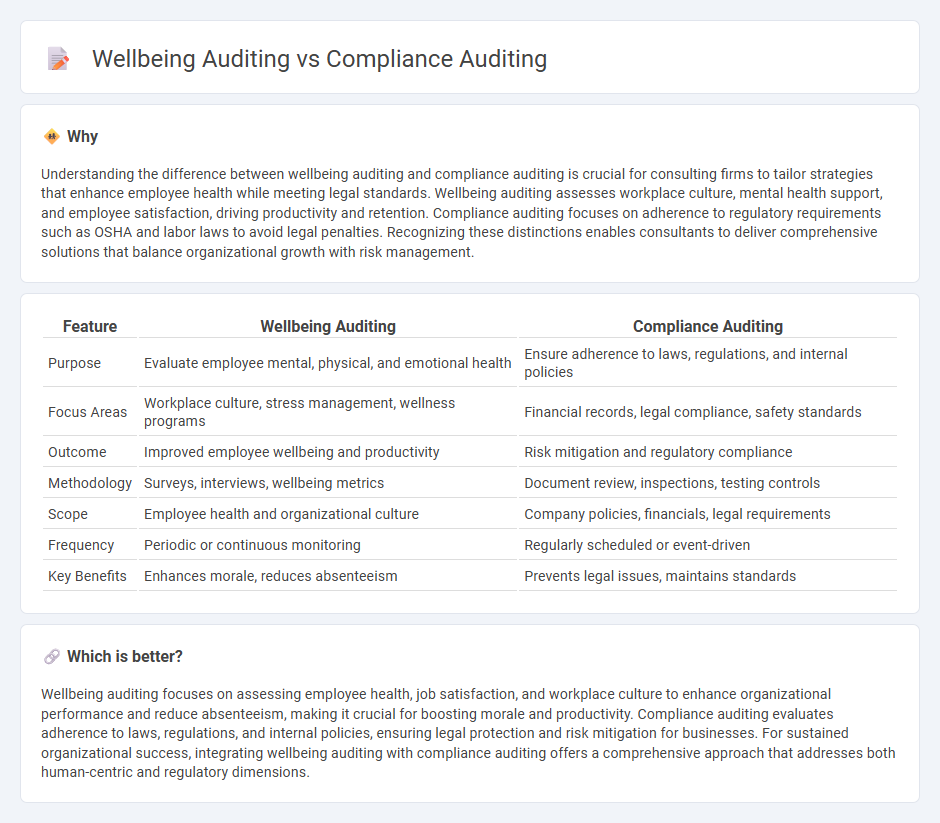
Wellbeing auditing evaluates organizational practices impacting employee health, engagement, and overall workplace culture, focusing on improving mental and physical wellness. Compliance auditing ensures adherence to legal regulations, industry standards, and internal policies, mitigating risks related to labor laws and safety requirements. Explore the differences between these audit types to enhance your company's productivity and regulatory standing.
Why it is important
Understanding the difference between wellbeing auditing and compliance auditing is crucial for consulting firms to tailor strategies that enhance employee health while meeting legal standards. Wellbeing auditing assesses workplace culture, mental health support, and employee satisfaction, driving productivity and retention. Compliance auditing focuses on adherence to regulatory requirements such as OSHA and labor laws to avoid legal penalties. Recognizing these distinctions enables consultants to deliver comprehensive solutions that balance organizational growth with risk management.
Comparison Table
| Feature | Wellbeing Auditing | Compliance Auditing |
|---|---|---|
| Purpose | Evaluate employee mental, physical, and emotional health | Ensure adherence to laws, regulations, and internal policies |
| Focus Areas | Workplace culture, stress management, wellness programs | Financial records, legal compliance, safety standards |
| Outcome | Improved employee wellbeing and productivity | Risk mitigation and regulatory compliance |
| Methodology | Surveys, interviews, wellbeing metrics | Document review, inspections, testing controls |
| Scope | Employee health and organizational culture | Company policies, financials, legal requirements |
| Frequency | Periodic or continuous monitoring | Regularly scheduled or event-driven |
| Key Benefits | Enhances morale, reduces absenteeism | Prevents legal issues, maintains standards |
Which is better?
Wellbeing auditing focuses on assessing employee health, job satisfaction, and workplace culture to enhance organizational performance and reduce absenteeism, making it crucial for boosting morale and productivity. Compliance auditing evaluates adherence to laws, regulations, and internal policies, ensuring legal protection and risk mitigation for businesses. For sustained organizational success, integrating wellbeing auditing with compliance auditing offers a comprehensive approach that addresses both human-centric and regulatory dimensions.
Connection
Wellbeing auditing and compliance auditing are interconnected through their focus on ensuring organizational adherence to health, safety, and regulatory standards, which ultimately enhances employee wellbeing and operational integrity. Wellbeing audits assess workplace conditions, mental health programs, and employee support systems, while compliance audits verify that these initiatives meet legal and industry regulations. Together, these audits create a comprehensive approach to maintaining a healthy, compliant, and productive work environment.
Key Terms
**Compliance Auditing:**
Compliance auditing evaluates an organization's adherence to laws, regulations, and internal policies to mitigate risks and ensure legal accountability. This process involves systematic examination of financial records, operational procedures, and reporting standards to identify discrepancies and ensure regulatory alignment. Explore further to understand how compliance auditing safeguards corporate governance and operational integrity.
Regulatory Standards
Compliance auditing emphasizes adherence to regulatory standards such as ISO 19600 or the Sarbanes-Oxley Act, ensuring organizations meet legal and policy requirements to mitigate risks. Wellbeing auditing, while less regulated by formal standards, focuses on assessing workplace health programs, psychological safety, and employee satisfaction metrics aligned with guidelines like ISO 45003. Explore how integrating both audits can enhance organizational governance and employee welfare in detail.
Risk Management
Compliance auditing rigorously evaluates adherence to legal regulations, industry standards, and internal policies to minimize risks related to regulatory penalties and operational failures. Wellbeing auditing centers on assessing employee health, safety, and overall workplace environment to mitigate risks associated with employee burnout, absenteeism, and decreased productivity. Explore how integrating both audits enhances comprehensive risk management strategies in your organization.
Source and External Links
What is Compliance Audit Procedure: Why It's Necessary and How ... - A compliance audit evaluates whether a company follows set standards by reviewing internal controls, infrastructure, and processes, conducted either externally or by regulators, concluding with a report outlining compliance status and recommendations for corrective actions within 120 days.
What is a compliance audit? Definition, strategy & reporting - Diligent - A compliance audit is an independent evaluation to ensure an organization follows relevant laws, regulations, policies, and procedures, providing documented evidence of compliance and assessing the effectiveness of internal controls.
What is compliance audit? | Definition from TechTarget - Compliance audits are comprehensive reviews of adherence to regulatory guidelines varying by industry, conducted internally or externally, and often required to confirm regulatory, data protection, and industry-specific standards compliance.
 dowidth.com
dowidth.com